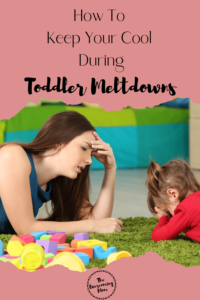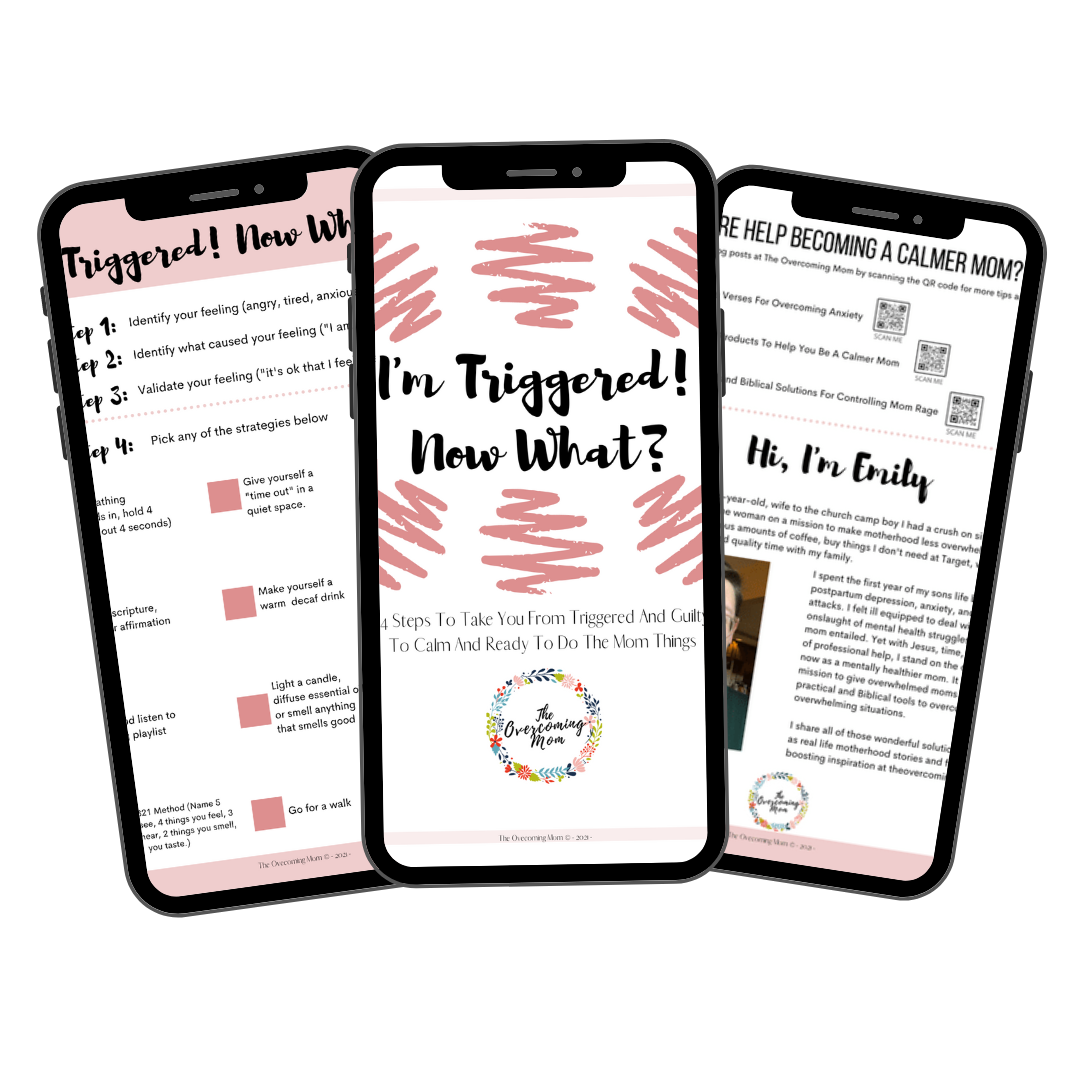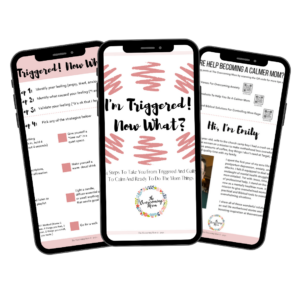This page may contain affiliate links. As an Amazon Associate I earn from qualifying purchases. If you want more information, please see my Affiliate Disclosure.

I always imagined myself being the mom who remained serene during toddler meltdowns. I told myself I’d never be the mom who loses their mind in the middle of the grocery store. My whole life I swore I’d never be the mom who yelled at my kid when they were throwing a tantrum.
Then I had an actual toddler, who had actual meltdowns.
I learned real quick that keeping my cool during a toddler meltdown was much harder than I anticipated. I gained way more sympathy for the mom who was falling apart in the middle of the grocery store, or who found themselves yelling way more than anticipated. Becoming a mom has opened up my eyes to just how difficult it can be to stay calm when your child isn’t.
What about Mom?
Before starting The Overcoming Mom and before becoming a parent, I was an elementary school music teacher. Even with grade school aged kids, I still had to calm tantrums. Many of the tricks and trades I learned in my teaching days helped with calming the meltdowns my own child had. Yet in all my years learning how to handle the big feelings of little people, nobody ever taught me how to handle my feelings in those moments.
As a teacher, when I worked with a child in the middle of an emotional crisis, I did a good job keeping a calm face, but inside I was about to explode. My anxiety was through the roof, but I had to shove it all down for the sake of my student. I experienced similar moments as a parent. My child would be losing his mind, I’d be doing my best to stay calm, but inside my mind was screaming “get me out of here!”
I’ve learned over the years that there are literally MILLIONS of resources out there for handling your toddlers tantrums. There are people out there making literally MILLIONS of dollars off of selling you courses on calming your toddlers tantrums. Though the information out there for those matters is great, helping moms handle their own emotions during tantrums is scarce. Yet moms all over are applying all the tricks and tools to handle their kids meltdowns, all while they’re melting down on the inside.
So how do we keep ourselves from melting down during a toddler meltdown? I’ve compiled 7 tips for keeping your cool in the throes of a toddler meltdown. These tips were created based off my experiences handling big feelings at home with my own child, as well as the big feelings of my former students. My hope is that the next time you find yourself managing a toddler tantrum, that you’d have the tools necessary to truly keep your cool.
1 – Remember Tantrums Have Nothing To Do With Your Parenting Skills
Toddler meltdowns can often feel like personal attacks on our parenting. Toddler meltdowns can lead us into a downward spiral of mom guilt if we’re not careful. The truth is that tantrums are a healthy milestone development, and they often have nothing to do with you as a parent. Remembering that your child’s big feelings have little to nothing to do with you as a parent relieves us of potential guilt.
When my son is having a meltdown, I sometimes visualize that I am behind bulletproof glass. It’s a reminder to me that his feelings can’t hurt me, and that I am safe, and my child is safe. Doing this helps me keep my cool tremendously. Putting up that metaphorical bulletproof glass is a reminder to me that my child’s tantrums won’t hurt my ego. That visual reminds me that no matter how big his feelings are, I am going to be ok through it.
Related: “5 Ways To Overcome Mom Guilt”
2 – Find The “Why” Behind The Meltdown
Toddler meltdowns often feel completely inexplicable. Sometimes they are, but most of the time there is an explanation for a tantrum. Investigating the “why” behind the meltdown can help us understand our child more, and give us the ability to empathize with our child better.
Finding out why your child is having a tantrum sometimes feels like playing charades. That’s especially true with pre-verbal kids. Finding the “why” behind the tantrum can be as easy as asking, or you may have to dig a little deeper. When you do understand why the meltdown happened, use that knowledge to empathize with your child.
Empathy can be a powerful tool in parenting. Your child is a human who feels their feelings bigger than most adults. When your child understand why they’re feeling their feelings, it can help them better vocalize their feelings later in life. When you understand why they’re feeling what they’re feeling, it helps you build empathy for your child. It can also help you take preventative measures in case a similar situation happens again.
3 – Give Your Kid’s Permission To Feel Their Feelings, And Give Yourself Permission To Feel As Well
One of the most healing phrases I’ve ever had someone say to me was simply, “it’s ok to be upset”. Hearing that reminded me that my feelings don’t determine who I am as a person. They only confirm that I am a person. When we communicate to our kids that their feelings are valid, and they’re allowed to feel them, we give them permission to be human.
Giving our kids permission to feel their feelings can sound like a lot of things. Here’s some examples:
- “You’re allowed to be upset.”
- “It’s ok to be sad.”
- “Sometimes I get frustrated too.”
Giving our kid’s permission to feel their feelings is great, but we often forget to extend that same grace to ourselves. Getting frustrated when your child has a tantrum does not make you a bad parent, it makes you a person. Give your own feelings the validation you give your kids.
The next time you tell your child, “You’re allowed to be upset,” say to yourself, “you’re allowed to be upset too”. If you find yourself crying while your child is crying, give you AND your child permission to cry. How beautiful of a moment that can be when we share that with our kids in a healthy way! Instead of shaming and shoving down our feelings, let’s validate them not just for our kids, but ourselves too.
4 – Hold Your Boundaries
It’s ok for all of us to have feelings, but feelings do not give us permission to make unwise choices. When our kids are in meltdown mode, they may also push boundaries. Most of the time, this is because kids in general have poor impulse control. Have you ever been so angry that you’ve wanted to punch a hole in the wall? But would you ever actually do it? Probably not. Your child is feeling a feeling that’s so big that they want to do something wild to blow off the steam, but they lack the impulse control to not do it.
Our jobs as parents is to help them understand their feelings, as well as understand what is acceptable and unacceptable to do with them. This is where good boundaries come into play. My favorite phrase I use when drawing a boundary with my toddler is, “I can’t let you.” Let me give you some examples:
- “It’s ok to be angry. I can’t let you hit me.”
- “It’s ok that your toy is frustrating you. I can’t let you throw it.”
Coupling the feeling validation with the boundary I find makes it much more effective. I’ve used this strategy many times when handling meltdowns in the classroom during my teaching days. It’s a great reminder that their feeling is perfectly valid, but their action is not the best for the situation. The next step I find is the perfect cherry on top for cooling off a meltdown.
5 – Give Controlled Choices
Children love to be in control! When you think about it, kids often don’t get much choice in their lives. Giving them a little bit of choice can go a long way, but it also matters how we give them choice.
Little minds may love to have choices, but often struggle when there’s too many choices. As parents, it can also be very frustrating when we give choices, but they choose something we don’t or can’t let them have. Giving a controlled, or a win/win choice is a fantastic compromise that allows kids to sort of be in control, but mom still has the control.
A good example I use a lot is with getting dressed in the morning. My toddler LOVES to wear his pajamas. When it’s time to get dressed in the morning, most of the time it results in some strong feelings and resounding “I just want to wear my jammies!” I usually follow up with the formula of validate-boundary-choice. I say, “it’s ok that you upset about getting dressed. We’re going to take our jammies off and get an outfit on. Would you like to wear your dinosaur shirt or your bear shirt?” Nine times out of ten, he’s content with getting dressed when he has a little bit of a say in what we wears.
The key to controlled choices is to limit the choices to two (maybe three for older kids), and to make all the options good options. If your child is one who likes to create their own options, hold the boundary. Remind them that the options that were given are their choices, and give them time to choose. Sometimes some kids don’t want to choose, and that’s fine too. When my son isn’t in the mood to choose his outfit, I choose for him. Sometime’s he’s fine with it, other times he’s not. When he’s not, I validate that feeling, and remind him that he wanted me to choose. I hold the boundary, and tell him he can choose next time.
6 – Let The Storm Roll By
Some toddler meltdowns are ones that are just inexplicable and just plain strange. Perhaps you have an overtired toddler whose final straw was pulled for the night. Maybe you have a child that you’ve done all of the steps with, but they’re still breaking the Richter scale with their screams. Some storms can be calmed with all the steps, and others you just have to weather them.
If you’ve exhausted all of your techniques and your child still isn’t having it, simply validating how they feel and sitting with them can be all they need. Often when my son is inconsolable, I offer him a hug, and ride out the storm with him. Sometimes I talk to him through it, other times I’m quiet. It truly depends on the situation and what you know works best for your child.
Some kids like to be alone when they’re having meltdowns. Occasionally my son will run off to a corner and scream “I want to be alone!” We personally don’t do time-outs in our house, so we will remain nearby and tell him we’re here for him when he’s ready. Other people utilize calming corners for moments like this. Here’s a really great blog post all about calming corners if you’re interested.
7 – Give Yourself A Time Out
People often utilize time outs for kids, but the truth is that they may be more effective for adults! When your kid is a 10/10 on the meltdown scale, and you’re about to be as well, sometimes you need to tap out and walk away.
My husband and I utilized this often when our son was a baby. If at any moment either one of us felt overwhelmed, we’d say “I tap out” and we’d walk away. The other parent would step in, while the other took a calming break somewhere else. Creating some kind of a system with your spouse during heated moments with your toddler can be a great tool for keeping your cool.
What if you’re parenting alone at the moment? Perhaps you’re a single parent, or the other parent is away? Taking your child to another safe space in the house while you cool off somewhere else can be a great alternative. Sometimes I utilize sensory bins or TV time when I need a moment to cool down. The key is that you’re giving yourself a moment to cool down before you also blow your gasket, but giving your child a safe place to be.
8 – Give Yourself A Sensory Break
In my teaching days, we often utilized our school sensory room for kids who we’re experiencing overstimulation. Many of the classroom teachers had sensory corners for overstimulated students to use as well. In my handful of times in my former school’s sensory room, I wondered “why can’t the adults use this as well? This is fantastic!”
In case you’re unfamiliar with sensory breaks, it’s a time of day when a child does some kind of activity that calms their senses and regulates their emotions. Sensory breaks are a common occupational therapy tool used with children, and many schools utilize them as well. You sometimes see some sensory practices overlap into parenting circles such as ball pits, trampolines, rice bins, fidgeters, and sensory chairs. We utilize these things with kids all the time, but adults need sensory breaks too! So how do we do that?
Using noise cancelling headphones when the house is getting too noisy can be great if you have noise sensitivities. Fidgeters are also wonderful for adults to use as well. Finding small times in the day to be in calm, quiet, dimly lit spaces are wonderful for calming the senses. I have a blog post with all kinds of products recommendations for sensory breaks for moms right here.
9 – If Keeping Your Cool Around Your Kids Is A Consistent Issue, Get Curious About Why
When we as parents are losing our cool in the middle of toddler meltdowns often, it may be more than a bad tantrum causing our anger. Think about it. How did your parents react to your toddler meltdowns?
For many of us, our child’s meltdowns send us back to times in our childhood where our meltdowns resulted in traumatizing moments. When our mind flashes back to those painful childhood moments, it can often lead us to feelings such as overwhelm, fear, anger, frustration, and sadness. Some people would call those moments being triggered. When we’re being triggered by toddler meltdowns because of our past, it may be worth our time to dig deeper into that and work towards a healthier way to cope with those triggers.
Sometimes toddler meltdowns don’t necessary trigger us because of past experiences, but because of sensory overload. Perhaps it is the noise that is sending you over the edge. Maybe it’s being excessively touched by your child. Or maybe it’s having your physical boundaries violated frequently. I actually have a blog post with great products that can help with managing sensory overload as a mom.
Seeing a therapist has been one of the best decisions I’ve made as a parent. I’ve come to understand that many of my reactions to my child’s tantrums had nothing to do with my child. My big feelings during my child’s meltdowns had more to do with my childhood than my child. Working though those feelings with a therapist has been hugely helpful for me.
Related: “5 Practical And Biblical Techniques For Controlling Mom Rage”
Keep Calm And Mom On
Being a mom has been one of the toughest thing’s I’ve ever done. It has challenged my emotions more than anything. Being a mom has challenged me to create a plan for when my emotional bandwidth is pushed because of tantrums.
Feeling big feelings when your child is having a meltdown is completely normal, and it is possible to handle them calmly and safely. I created a free resource for you called the “Calm Down Checklist.” It’s made specifically for overwhelmed moms who struggle with handling the big emotions that come along with the struggles of motherhood. You’ll find a free step-by-step guide on how to get from flipping your lid to cool and calm. You can sign up for free below.












